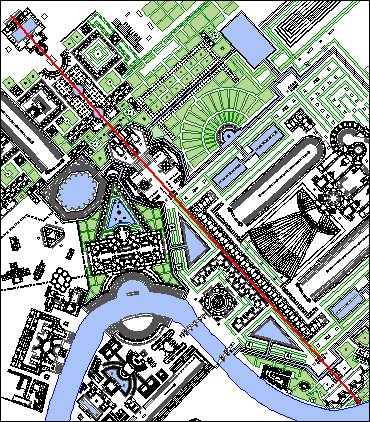euripus : a narrow channel, strait; a canal, conduit, aquaduct
Mars (Martis)
1998.07.23
The second temple of Mars, positioned on the west side of the Tiber at the foot of the Vatican Hill, sits within a hexagonal area labeled Apparatorium Triumphatorum -- the place of preparation for the triumphal march. In front of the temple and place of preparation is the decagonal Area Martis, which an euripus (canal/moat) encloses on two sides, and it is here that Piranesi indicates the beginning of the Triumphal Way. Besides the obvious ceremonial importance of the Area Martis, this place is also distinct within the Ichnographia: its ten-sided perimeter is the only such shape throughout the entire large plan. Significant also is the plan of the Templum Martis, whose ichnography resembles male genitalia. The deliberate connection between Mars and overt masculinity is unquestionable. Moreover, the Templum Martis, the Area Martis, and the beginning of the Triumphal Way together establish a principal axis, one of the three major axes present within the Ichnographia. This axis extends from the top of the Vatican Hill straight down to the bank of the Tiber across from the tomb of Augustus, and is not only great in length, but also rich in symbolism. Represented here is the mighty thrust of Mars, the dominance of Romulus, and hence the source of Rome and its unparalleled pride.

| |

The Templum Martis (top) is surrounded by a hexagonal place reserved for the preparation of the triumphal march. The Area Martis (below) is a large space in front of the Templum Martis and the place where the Triumphal Way begins (indicated in red).
The long axis running through the Templum and Area Martis (center) extends from the Nympheum Neronis atop the Vatican Hill (upper left) down to another Nymphaeum on the west bank of the Tiber (lower right).
|
| |
Ostium Euripi cum januis aperiendis et claudendis ad adjendas et elevandes naves ex inferiori profluente Tiberis in superioremsuperficiem aquae Naumachiae
--text labeling the sluice feeding the euripus surrounding and leading into the Naumachia Domitiani.
|

